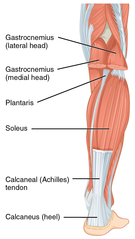Ścięgno Achillesa
| ||
| tendo Achillis, tendo calcaneus | ||
 | ||
Ścięgno Achillesa, ścięgno piętowe (łac. tendo Achillis, tendo calcaneus) – największe ścięgno w organizmie człowieka[1], tworzone przez łączące się ścięgna mięśnia brzuchatego łydki (łac. musculus gastrocnemius) i mięśnia płaszczkowatego (łac. musculus soleus)[2]. Jest szerokie i płaskie w części szczytowej, natomiast stopniowo zwęża się i grubieje ku dołowi. Kończy się wyraźnym poszerzeniem w miejscu jego przyczepu na guzie piętowym[2].
Nazwa tego ścięgna wywodzi się od mitycznego Achillesa[3].
Przypisy
- ↑ Ścięgno. W: Wielka Encyklopedia Medyczna. Enrico Cravetto (red.). T. 21: ści–uni. Warszawa: Planeta DeAgostini, 2011, s. 14. ISBN 978-83-268-0321-5.
- ↑ a b Adam Bochenek, Michał Reicher, Anatomia człowieka. Tom I. Anatomia ogólna. Kości, stawy i więzadła, mięśnie, wyd. XIII, Warszawa: Wydawnictwo Lekarskie PZWL, 2019, s. 900–901, ISBN 978-83-200-4323-5.
- ↑ Achilles' tendon w bazie Who Named It (ang.)
![]() Przeczytaj ostrzeżenie dotyczące informacji medycznych i pokrewnych zamieszczonych w Wikipedii.
Przeczytaj ostrzeżenie dotyczące informacji medycznych i pokrewnych zamieszczonych w Wikipedii.
Media użyte na tej stronie
The Star of Life, medical symbol used on some ambulances.
Star of Life was designed/created by a National Highway Traffic Safety Administration (US Gov) employee and is thus in the public domain.Autor: J. Gordon Betts, Kelly A. Young, James A. Wise, Eddie Johnson, Brandon Poe, Dean H. Kruse, Oksana Korol, Jody E. Johnson, Mark Womble, Peter DeSaix, Licencja: CC BY 4.0
Caption: The muscles of the anterior compartment of the lower leg are generally responsible for dorsiflexion, and the muscles of the posterior compartment of the lower leg are generally responsible for plantar flexion. The lateral and medial muscles in both compartments invert, evert, and rotate the foot.
URL: https://cnx.org/contents/FPtK1zmh@8.108:y9_gDy74@5/Appendicular-Muscles-of-the-Pe
Other versions:





